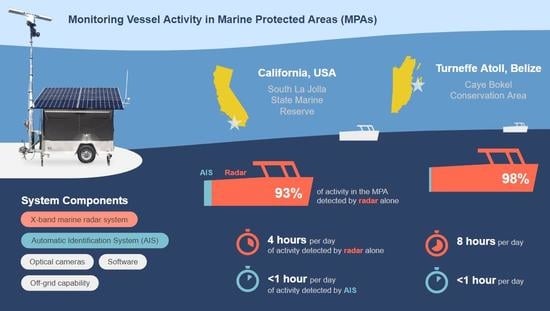Building a Practical Multi-Sensor Platform for Monitoring Vessel Activity near Marine Protected Areas: Case Studies from Urban and Remote Locations
Abstract
:1. Introduction
1.1. Related Work
1.2. System Overview
2. Materials and Methods
2.1. Radar Tracking
2.2. AIS Data and Track Association
- detections are within 100 m in geolocation,
- difference in speed less than 1.5 knots (0.77 m/s),
- difference in course less than 10 degrees, and
- detected within 15 s.
2.3. Track Analysis
2.4. Camera Integration
2.5. Camera Calibration
2.6. Target Selection and Cuing
2.7. Case Study Analysis
3. Results
4. Discussion
5. Conclusions
Author Contributions
Funding
Data Availability Statement
Acknowledgments
Conflicts of Interest
References
- Convention on Biological Diversity. First Draft of the Post-2020 Global Biodiversity Framework CBD/WG2020/3/3. 2021. Available online: https://www.cbd.int/doc/c/abb5/591f/2e46096d3f0330b08ce87a45/wg2020-03-03-en.pdf (accessed on 13 April 2023).
- Maxwell, S.M.; Ban, N.C.; Morgan, L.E. Pragmatic approaches for effective management of pelagic marine protected areas. Endanger. Species Res. 2014, 26, 59–74. [Google Scholar] [CrossRef] [Green Version]
- Wilhelm, T.; Sheppard, C.R.C.; Sheppard, A.L.S.; Gaymer, C.F.; Parks, J.; Wagner, D.; Lewis, N. Large marine protected areas–advantages and challenges of going big. Aquat. Conserv. 2014, 24, 24–30. [Google Scholar] [CrossRef]
- Rowlands, G.; Brown, J.; Soule, B.; Boluda, P.T.; Rogers, A.D. Satellite surveillance of fishing vessel activity in the Ascension Island Exclusive Economic Zone and Marine Protected Area. Mar. Policy 2019, 101, 39–50. [Google Scholar] [CrossRef]
- White, T.D.; Ong, T.; Ferretti, F.; Block, B.A.; McCauley, D.J.; Micheli, F.; de Leo, G.A. Tracking the response of industrial fishing fleets to large marine protected areas in the Pacific Ocean. Conserv. Biol. 2020, 34, 1571–1578. [Google Scholar] [CrossRef]
- Albers, H.J.; Ashworth, M.F. Economics of marine protected areas: Assessing the literature for marine protected area network expansions. Annu. Rev. Resour. Econ. 2022, 14, 533–554. [Google Scholar] [CrossRef]
- Bayley, D.T.I.; Mogg, A.O.M.; Purvis, A.; Koldewey, H.J. Evaluating the efficacy of small-scale marine protected areas for preserving reef health: A case study applying emerging monitoring technology. Aquat. Conserv. 2019, 29, 2026–2044. [Google Scholar] [CrossRef]
- Mascia, M.B.; Claus, C.A.; Naidoo, R. Impacts of marine protected areas on fishing communities. Conserv. Biol. 2010, 24, 1424–1429. [Google Scholar] [CrossRef]
- Gill, D.A.; Mascia, M.B.; Ahmadia, G.N.; Glew, L.; Lester, S.E.; Barnes, M.; Craigie, I.; Darling, E.S.; Free, C.M.; Geldmann, J.; et al. Capacity shortfalls hinder the performance of marine protected areas globally. Nature 2017, 543, 665–669. [Google Scholar] [CrossRef]
- Appleton, M.R.; Courtiol, A.; Emerton, L.; Slade, J.L.; Tilker, A.; Warr, L.C.; Malvido, M.A.; Barborak, J.R.; de Bruin, L.; Chapple, R.; et al. Protected area personnel and ranger numbers are insufficient to deliver global expectations. Nat. Sustain. 2022, 5, 1100–1110. [Google Scholar] [CrossRef]
- Kanjir, U.; Greidanus, H.; Oštir, K. Vessel detection and classification from spaceborne optical images: A literature survey. Remote Sens. Environ. 2018, 207, 1–26. [Google Scholar] [CrossRef]
- Snapir, B.; Waine, T.W.; Biermann, L. Maritime vessel classification to monitor fisheries with SAR: Demonstration in the North Sea. Remote Sens. 2019, 11, 353. [Google Scholar] [CrossRef] [Green Version]
- Song, J.; Kim, D.; Kang, K. Automated procurement of training data for machine learning algorithm on ship detection using AIS information. Remote Sens. 2020, 12, 1443. [Google Scholar] [CrossRef]
- Morgera, E.; Ntona, M. Linking small-scale fisheries to international obligations on marine technology transfer. Mar. Policy 2018, 93, 295–306. [Google Scholar] [CrossRef]
- Marine Monitor: Solution for Situational Awareness of the Nearshore Marine Environment. Available online: https://m2marinemonitor.com/ (accessed on 18 April 2023).
- Robards, M.D.; Silber, G.K.; Adams, J.D.; Arroyo, J.; Lorenzini, D.; Schwehr, K.; Amos, J. Conservation science and policy applications of the marine vessel Automatic Identification System (AIS)—A review. Bull. Mar. Sci. 2016, 92, 75–103. [Google Scholar] [CrossRef]
- McCauley, D.J.; Woods, P.; Sullivan, B.; Bergman, B.; Jablonicky, C.; Roan, A.; Hirshfield, M.; Boerder, K.; Worm, B. Ending hide and seek at sea. Science 2016, 351, 1148–1150. [Google Scholar] [CrossRef] [Green Version]
- Dureuil, M.; Boerder, K.; Burnett, K.A.; Froese, R.; Worm, B. Elevated trawling inside protected areas undermines conservation outcomes in a global fishing hot spot. Science 2018, 362, 1403–1407. [Google Scholar] [CrossRef] [PubMed] [Green Version]
- Tassetti, A.N.; Ferrà, C.; Fabi, G. Rating the effectiveness of fishery-regulated areas with AIS data. Ocean Coast. Manag. 2019, 175, 90–97. [Google Scholar] [CrossRef]
- Perry, A.L.; Blanco, J.; García, S.; Fournier, N. Extensive use of habitat-damaging fishing gears inside habitat-protecting marine protected areas. Front. Mar. Sci. 2022, 9, 811926. [Google Scholar] [CrossRef]
- Iacarella, J.C.; Burke, L.; Davidson, I.C.; DiBacco, C.; Therriault, T.W.; Dunham, A. Unwanted networks: Vessel traffic heightens the risk of invasions in marine protected areas. Biol. Conserv. 2020, 245, 108553. [Google Scholar] [CrossRef]
- Boljat, H.U.; Grubišić, N.; Slišković, M. The impact of nautical activities on the environment—A systematic review of research. Sustainability 2021, 13, 10552. [Google Scholar] [CrossRef]
- Meijles, E.W.; Daams, M.N.; Ens, B.J.; Heslinga, J.H.; Sijtsma, F.J. Tracked to protect—Spatiotemporal dynamics of recreational boating in sensitive marine natural areas. Appl. Geogr. 2021, 130, 102441. [Google Scholar] [CrossRef]
- Kroodsma, D.A.; Mayorga, J.; Hochberg, T.; Miller, N.A.; Boerder, K.; Ferretti, F.; Wilson, A.; Bergman, B.; White, T.D.; Block, B.A.; et al. Tracking the global footprint of fisheries. Science 2018, 359, 904–908. [Google Scholar] [CrossRef] [PubMed] [Green Version]
- Welch, H.; Clavelle, T.; White, T.D.; Cimino, M.A.; Van Osdel, J.; Hochberg, T.; Kroodsma, D.; Hazen, E.L. Hot spots of unseen fishing vessels. Sci. Adv. 2022, 8, eabq2109. [Google Scholar] [CrossRef] [PubMed]
- Bunwaree, P. The illegality of fishing vessels ‘going dark’ and methods of deterrence. Int. Comp. Law Q. 2023, 72, 179–211. [Google Scholar] [CrossRef]
- Taconet, M.; Kroodsma, D.; Fernandes, J.A. Global Atlas of AIS-Based Fishing Activity—Challenges and Opportunities; Food and Agriculture Organization (FAO): Rome, Italy, 2019; Available online: https://agris.fao.org/agris-search/search.do?recordID=XF2020000847 (accessed on 14 April 2023).
- Cope, S.; Hines, E.; Bland, R.; Davis, J.D.; Tougher, B.; Zetterlind, V. Application of a new shore-based vessel traffic monitoring system within San Francisco Bay. Front. Mar. Sci. 2020, 7, 86. [Google Scholar] [CrossRef] [Green Version]
- Iacarella, J.C.; Burke, L.; Clyde, G.; Wicks, A.; Clavelle, T.; Dunham, A.; Rubidge, E.; Woods, P. Application of AIS- and flyover-based methods to monitor illegal and legal fishing in Canada’s Pacific marine conservation areas. Conserv. Sci. Pract. 2023, e12926. [Google Scholar] [CrossRef]
- O’Hara, P.D.; Serra-Sogas, N.; McWhinnie, L.; Pearce, K.; Le Baron, N.; O’Hagan, G.; Nesdoly, A.; Marques, T.; Canessa, R. Automated identification system for ships data as a proxy for marine vessel related stressors. Sci. Total Environ. 2023, 865, 160987. [Google Scholar] [CrossRef]
- Soldi, G.; Gaglione, D.; Forti, N.; Di Simone, A.; Daffin, F.C.; Bottini, G.; Quattrociocchi, D.; Millefiori, L.M.; Braca, P.; Carniel, S.; et al. Space-based global maritime surveillance. Part I: Satellite technologies. IEEE Aerosp. Electron. Syst. Mag. 2021, 36, 8–28. [Google Scholar] [CrossRef]
- Marino, A.; Sanjuan-Ferrer, M.J.; Hajnsek, I.; Ouchi, K. Ship detection with spectral analysis of synthetic aperture radar: A comparison of new and well-known algorithms. Remote Sens. 2015, 7, 5416–5439. [Google Scholar] [CrossRef]
- Stasolla, M.; Mallorqui, J.J.; Margarit, G.; Santamaria, C.; Walker, N. A comparative study of operational vessel detectors for maritime surveillance using satellite-borne synthetic aperture radar. IEEE J. Sel. Top. Appl. Earth Obs. Remote Sens. 2016, 9, 2687–2701. [Google Scholar] [CrossRef] [Green Version]
- Reggiannini, M.; Righi, M.; Tampucci, M.; Duca, A.L.; Bacciu, C.; Bedini, L.; D’Errico, A.; Di Paola, C.; Marchetti, A.; Martinelli, M.; et al. Remote sensing for maritime prompt monitoring. J. Mar. Sci. Eng. 2019, 7, 202. [Google Scholar] [CrossRef] [Green Version]
- Ruiz, J.; Caballero, I.; Navarro, G. Sensing the same fishing fleet with AIS and VIIRS: A seven-year assessment of squid jiggers in FAO major fishing area 41. Remote Sens. 2019, 12, 32. [Google Scholar] [CrossRef] [Green Version]
- Li, Y.; Song, L.; Zhao, S.; Zhao, D.; Wu, Y.; You, G.; Kong, A.; Xi, X.; Yu, Z. Nighttime fishing vessel observation in Bohai Sea based on VIIRS fishing vessel detection product (VBD). Fish. Res. 2023, 258, 106539. [Google Scholar] [CrossRef]
- Elvidge, C.D.; Zhizhin, M.; Baugh, K.; Hsu, F. Automatic boat identification system for VIIRS low light imaging data. Remote Sens. 2015, 7, 3020–3036. [Google Scholar] [CrossRef] [Green Version]
- Tsuda, M.E.; Miller, N.A.; Saito, R.; Park, J.; Oozeki, Y. Automated VIIRS boat detection based on machine learning and its application to monitoring fisheries in the East China Sea. Remote Sens. 2023, 15, 2911. [Google Scholar] [CrossRef]
- Yao, Y.; Jiang, Z.; Zhang, H.; Zhou, Y. On-board ship detection in micro-nano satellite based on deep learning and COTS component. Remote Sens. 2019, 11, 762. [Google Scholar] [CrossRef] [Green Version]
- Christopher, K. Port Security Management, 2nd ed.; CRC Press: Boca Raton, FL, USA, 2014. [Google Scholar] [CrossRef]
- Watson, G.J.; Murray, J.M.; Schaefer, M.; Bonner, A. Successful local marine conservation requires appropriate educational methods and adequate enforcement. Mar. Policy 2015, 52, 59–67. [Google Scholar] [CrossRef] [Green Version]
- Hartill, B.W.; Taylor, S.M.; Keller, K.; Weltersbach, M.S. Digital camera monitoring of recreational fishing effort: Applications and challenges. Fish Fish. 2020, 21, 204–215. [Google Scholar] [CrossRef]
- Parnell, P.E.; Dayton, P.K.; Fisher, R.A.; Loarie, C.C.; Darrow, R.D. Spatial patterns of fishing effort off San Diego: Implications for zonal management and ecosystem function. Ecol. Appl. 2010, 20, 2203–2222. [Google Scholar] [CrossRef]
- Keller, K.; Steffe, A.S.; Lowry, M.; Murphy, J.J.; Suthers, I.M. Monitoring boat-based recreational fishing effort at a nearshore artificial reef with a shore-based camera. Fish. Res. 2016, 181, 84–92. [Google Scholar] [CrossRef]
- Wood, G.; Lynch, T.P.; Devine, C.; Keller, K.; Figueira, W. High-resolution photo-mosaic time-series imagery for monitoring human use of an artificial reef. Ecol. Evol. 2016, 6, 6963–6968. [Google Scholar] [CrossRef] [Green Version]
- Lancaster, D.; Dearden, P.; Haggarty, D.R.; Volpe, J.P.; Ban, N.C. Effectiveness of shore-based remote camera monitoring for quantifying recreational fisher compliance in marine conservation areas. Aquat. Conserv. 2017, 27, 804–813. [Google Scholar] [CrossRef]
- Powers, S.P.; Anson, K. Estimating recreational effort in the Gulf of Mexico red snapper fishery using boat ramp Cameras: Reduction in federal season length does not proportionally reduce catch. N. Am. J. Fish. Manag. 2016, 36, 1156–1166. [Google Scholar] [CrossRef]
- Hartill, B.W.; Payne, G.W.; Rush, N.; Bian, R. Bridging the temporal gap: Continuous and cost-effective monitoring of dynamic recreational fisheries by web cameras and creel surveys. Fish. Res. 2016, 183, 488–497. [Google Scholar] [CrossRef]
- Wawrzyniak, N.; Hyla, T.; Popik, A. Vessel detection and tracking method based on video surveillance. Sensors 2019, 19, 5230. [Google Scholar] [CrossRef] [PubMed] [Green Version]
- Carić, H.; Cukrov, N.; Omanović, D. Nautical tourism in marine protected areas (MPAs): Evaluating an impact of copper emission from antifouling coating. Sustainability 2021, 13, 11897. [Google Scholar] [CrossRef]
- Harasti, D.; Davis, T.R.; Jordan, A.; Erskine, L.; Moltschaniwskyj, N. Illegal recreational fishing causes a decline in a fishery targeted species (Snapper: Chrysophrys auratus) within a remote no-take marine protected area. PLoS ONE 2019, 14, e0209926. [Google Scholar] [CrossRef] [Green Version]
- International Association of Marine Aids to Navigation and Lighthouse Authorities. IALA VTS Manual Ed. 8.2. International Association of Marine Aids to Navigation and Lighthouse Authorities. 2022. Available online: https://www.iala-aism.org/product/m0002/ (accessed on 10 June 2023).
- Xiao, Z.; Fu, X.; Zhang, L.; Goh, R.S.M. Traffic pattern mining and forecasting technologies in maritime traffic service networks: A comprehensive survey. IEEE Trans. Intell. Transp. Syst. 2019, 21, 1796–1825. [Google Scholar] [CrossRef]
- Xiao, Z.; Fu, X.; Zhao, L.; Zhang, L.; Teo, T.K.; Li, N.; Zhang, W.; Qin, Z. Next-generation vessel traffic services systems—From “passive” to “proactive”. IEEE Intell. Transp. Syst. Mag. 2022, 15, 363–377. [Google Scholar] [CrossRef]
- Li, J.; Yang, Y.; Li, X.; Sun, J.; Li, R. Knowledge-transfer-based bidirectional vessel monitoring system for remote and nearshore images. J. Mar. Sci. Eng. 2023, 11, 1068. [Google Scholar] [CrossRef]
- Dekker, R.; Bouma, H.; den Breejen, E.; van den Broek, B.; Hanckmann, P.; Hogervorst, M.; Mohamoud, A.; Schoemaker, R.; Sijs, J.; Tan, R.; et al. Maritime situation awareness capabilities from satellite and terrestrial sensor systems. In Proceedings of the Maritime Systems and Technology Conference and Exhibition, (MAST Europe), Gdansk, Poland, 4–6 June 2013. [Google Scholar]
- Khan, C.B.; Goetz, K.T.; Cubaynes, H.C.; Robinson, C.; Murnane, E.; Aldrich, T.; Sackett, M.; Clarke, P.J.; LaRue, M.A.; White, T.; et al. A biologist’s guide to the galaxy: Leveraging artificial intelligence and very high-resolution satellite imagery to monitor marine mammals from space. J. Mar. Sci. Eng. 2023, 11, 595. [Google Scholar] [CrossRef]
- Martellato, E.; Piccirillo, A.M.; Ferraioli, G.; Rotundi, A.; Della Corte, V.; Palumbo, P.; Alcaras, E.; Appolloni, L.; Aulicino, G.; Bertini, I.; et al. A new orbiting deployable system for small satellite observations for ecology and Earth observation. Remote Sens. 2022, 14, 2066. [Google Scholar] [CrossRef]
- Lin, Y.; Li, J.; Zhou, Z.; Luo, Q.; Wang, C.; Yan, X. Simulation analysis of the satellite coverage performance for identifying illegal fishing in target sea area. In Proceedings of the 2022 Global Reliability and Prognostics and Health Management (PHM-Yantai), Yantai, China, 13–16 October 2022. [Google Scholar] [CrossRef]
- Lin, B.; Huang, C. Comparison between ARPA radar and AIS characteristics for vessel traffic services. J. Mar. Sci. Technol. 2006, 14, 7. [Google Scholar] [CrossRef]
- Kazimierski, W.; Stateczny, A. Radar and Automatic Identification System track fusion in an electronic chart display and information system. J. Navig. 2015, 68, 1141–1154. [Google Scholar] [CrossRef]
- Zainuddin, S.; Pasya, I.; Rashid, N.E.; Zaiaami, N.; Maryam, A.; Abdullah, R.; Ali, M.S. Maritime radar: A review on techniques for small Vessel detection. Int. J. Electr. Electron. Syst. Res. 2019, 14, 30–45. [Google Scholar]
- López, J.J.; Mulero-Pázmány, M. Drones for conservation in protected areas: Present and future. Drones 2018, 3, 10. [Google Scholar] [CrossRef] [Green Version]
- Provost, E.J.; Butcher, P.A.; Coleman, M.A.; Kelaher, B.P. Assessing the viability of small aerial drones to quantify recreational fishers. Fish. Manag. Ecol. 2020, 27, 615–621. [Google Scholar] [CrossRef]
- Molina-Molina, J.C.; Salhaoui, M.; Guerrero-González, A.; Arioua, M. Autonomous marine robot based on AI recognition for permanent surveillance in marine protected areas. Sensors 2021, 21, 2664. [Google Scholar] [CrossRef] [PubMed]
- Kurekin, A.A.; Loveday, B.R.; Clements, O.; Quartly, G.D.; Miller, P.I.; Wiafe, G.; Agyekum, K.A. Operational monitoring of illegal fishing in Ghana through exploitation of satellite Earth observation and AIS data. Remote Sens. 2019, 11, 293. [Google Scholar] [CrossRef] [Green Version]
- Park, J.; Lee, J.; Seto, K.; Hochberg, T.; Wong, B.A.; Miller, N.A.; Takasaki, K.; Kubota, H.; Oozeki, Y.; Doshi, S.; et al. Illuminating dark fishing fleets in North Korea. Sci. Adv. 2020, 6, eabb1197. [Google Scholar] [CrossRef] [PubMed]
- TimeZero Coastal Monitoring. Available online: https://www.coastalmonitoring.com/ (accessed on 18 April 2023).
- French, A.P. How far away is the horizon? Am. J. Phys. 1982, 50, 795–799. [Google Scholar] [CrossRef] [Green Version]
- Bole, A.G.; Wall, A.D.; Norris, A. Radar and ARPA Manual: Radar, AIS, and Target Tracking for Marine Radar Users, 3rd ed.; Butterworth-Heinemann: Oxford, UK, 2014; ISBN 978-0080977522. [Google Scholar]
- Nobeltec TimeZero User Guide; TIMEZERO, 2023. Available online: https://userguide.mytimezero.com/tz-coastal-monitoring (accessed on 18 April 2023).
- Furuno Software Development Kit. Available online: https://www.furunousa.com/en/sdk (accessed on 18 April 2023).
- Lee, J.; South, A.B.; Jennings, S. Developing reliable, repeatable, and accessible methods to provide high resolution estimates of fishing-effort distributions from vessel monitoring system (VMS) data. ICES J. Mar. Sci. 2010, 67, 1260–1271. [Google Scholar] [CrossRef] [Green Version]
- de Souza, E.N.; Boerder, K.; Matwin, S.; Worm, B. Improving fishing pattern detection from satellite AIS using data mining and machine learning. PLoS ONE 2016, 11, e0158248. [Google Scholar] [CrossRef]
- Huang, H.; Hong, F.; Liu, J.; Liu, C.; Feng, Y.; Guo, Z. FVID: Fishing vessel type identification based on VMS trajectories. J. Ocean Univ. China 2018, 18, 403–412. [Google Scholar] [CrossRef]
- Cope, S.; Zetterlind, V.; Tougher, B. Integrating marine radar in a multi-sensor platform for remote, unsupervised vessel tracking in the nearshore environment. In Proceedings of the Global Oceans 2020: Singapore—U.S. Gulf Coast, Biloxi, MS, USA, 5–20 October 2020; pp. 1–5. [Google Scholar] [CrossRef]
- Cope, S.; Tougher, B.; Morten, J.; Pukini, C.; Zetterlind, V. Coastal radar as a tool for continuous and fine-scale monitoring of vessel activities of interest in the vicinity of marine protected areas. PLoS ONE 2022, 17, e0269490. [Google Scholar] [CrossRef] [PubMed]
- Jianmin, Z.; Jie, W. Intelligent vessel dynamics video monitoring system based on AIS data. In Proceedings of the 2009 IEEE International Conference on Systems, Man and Cybernetics, San Antonio, TX, USA, 11–14 October 2009. [Google Scholar] [CrossRef]
- Yoshihara, K.; Yamamoto, S.; Hashimoto, T. Real-time tracking of offshore vessel using pan-tilt camera for keeping a lookout. Mar. Eng. 2018, 53, 429–434. [Google Scholar] [CrossRef] [Green Version]
- Loomans, M.J.H.; de With, P.H.N.; Wijnhoven, R.G.J. Robust automatic ship tracking in harbours using active cameras. In Proceedings of the 2013 IEEE International Conference on Image Processing, Melbourne, Australia, 15–18 September 2013. [Google Scholar] [CrossRef]
- Helgesen, H.H.; Leira, F.S.; Fossen, T.I.; Johansen, T.A. Tracking of ocean surface objects from unmanned aerial vehicles with a pan/tilt unit using a thermal camera. J. Intell. Robot. Syst. 2018, 91, 775–793. [Google Scholar] [CrossRef] [Green Version]
- Sabirin, H.; Bäse, G. Video surveillance of today: Compressed domain object detection, ONVIF web services based system component communication and standardized data storage and export using VSAF—A walkthrough. In Video Surveillance; Lin, W., Ed.; Intech: London, UK, 2011; pp. 37–54. ISBN 978-953-307-436-8. [Google Scholar]
- Nguyen, K.Q.; Winger, P.D. Artificial light in commercial industrialized fishing applications: A review. Rev. Fish. Sci. Aquac. 2018, 27, 106–126. [Google Scholar] [CrossRef] [Green Version]
- International Telecommunication Union. Recommendation M.1371-5 Technical Characteristics for an Automatic Identification System Using Time Division Multiple Access in the VHF Maritime Mobile Frequency Band; International Telecommunication Union: Geneva, Switzerland, 2014; Available online: https://www.itu.int/rec/R-REC-M.1371-5-201402-I/en (accessed on 10 June 2023).
- Todd, P.A.; Heery, E.C.; Loke, L.H.L.; Thurstan, R.H.; Kotze, D.J.; Swan, C. Towards an urban marine ecology: Characterizing the drivers, patterns and processes of marine ecosystems in coastal cities. Oikos 2019, 128, 1215–1242. [Google Scholar] [CrossRef] [Green Version]
- Weekers, D.P.; Zahnow, R.; Mazerolle, L. Conservation criminology: Modelling offender target selection for illegal fishing in marine protected areas. Br. J. Criminol. 2019, 59, 1455–1477. [Google Scholar] [CrossRef]
- Nickols, K.J.; White, J.W.; Malone, D.; Carr, M.H.; Starr, R.M.; Baskett, M.L.; Hastings, A.; Botsford, L.W. Setting ecological expectations for adaptive management of marine protected areas. J. Appl. Ecol. 2019, 56, 2376–2385. [Google Scholar] [CrossRef]
- Albers, H.J.; Preonas, L.; Capitán, T.; Robinson, E.J.Z.; Madrigal-Ballestero, R. Optimal siting, sizing, and enforcement of marine protected areas. Environ. Resour. Econ. 2020, 77, 229–269. [Google Scholar] [CrossRef]
- California Department of Fish and Wildlife. California’s Marine Protected Area Network Decadal Management Review; California Department of Fish and Wildlife: Sacramento, CA, USA, 2022. Available online: https://wildlife.ca.gov/Conservation/Marine/MPAs/Management/Decadal-Review (accessed on 16 April 2023).
- California Department of Fish and Wildlife. MPA Outreach Materials; California Department of Fish and Wildlife: Sacramento, CA, USA, 2016. Available online: https://wildlife.ca.gov/Conservation/Marine/MPAs/Outreach-Materials (accessed on 16 April 2023).
- Belize Fisheries Department. Turneffe Atoll Marine Reserve Management Plan; Belize Fisheries Department: Belize City, Belize, 2011; Available online: http://www.turneffeatollmarinereserve.org/reserve-management (accessed on 16 April 2023).
- Rader, D.; Requena, N.; Wade, B.; Burden, M. Combining rights-based management with science-based marine protected area networks to sustain fisheries against climate impacts in Belize. In Adaptive Management of Fisheries in Response to Climate Change; FAO Fisheries and Aquaculture Technical Paper No., 667, Bahri, T., Vasconcellos, M., Welch, D.J., Johnson, J., Perry, R.I., Ma, X., Sharma, R., Eds.; Food and Agriculture Organization (FAO): Rome, Italy, 2021; pp. 115–126. ISBN 978-92-5-133890-2. [Google Scholar]
- Belize Fisheries Department. Statutory Instrument No. 111 of 2012 Fisheries (Turneffe Atoll Marine Reserve) Regulations; Belize Fisheries Department: Belize City, Belize, 2012. Available online: http://www.turneffeatollmarinereserve.org/reserve-management (accessed on 16 April 2023).
- Belize Fisheries Department. Statutory Instrument No. 161 of 2003 Fisheries (Spawning Aggregation Site Reserves) Order; Belize Fisheries Department: Belize City, Belize, 2003. Available online: http://www.spagbelize.org/Legislation.aspx (accessed on 16 April 2023).
- Stelzenmüller, V.; Rogers, S.I.; Mills, C.M. Spatio-temporal patterns of fishing pressure on UK marine landscapes, and their implications for spatial planning and management. ICES J. Mar. Sci. 2008, 65, 1081–1091. [Google Scholar] [CrossRef] [Green Version]
- R: A Language and Environment for Statistical Computing. R Core Team: Vienna, Austria, 2022. Available online: https://www.R-project.org/ (accessed on 17 April 2023).
- California Department of Fish and Wildlife. Ocean Sport Fishing Regulations; California Department of Fish and Wildlife: Sacramento, CA, USA, 2022. Available online: https://wildlife.ca.gov/Fishing/Ocean/Regulations/Sport-Fishing (accessed on 17 April 2023).
- California Department of Fish and Wildlife. Law Enforcement Division Citation Summary 2011; California Department of Fish and Wildlife: Sacramento, CA, USA, 2011. Available online: https://nrm.dfg.ca.gov/FileHandler.ashx?DocumentID=86746&inline (accessed on 17 April 2023).
- Ford, T.; Burdick, H.; Barilotti, A.; House, P. Aerial Monitoring of Ocean Vessels in Southern California, March 2017–Annual Project Report; The Bay Foundation, LightHawk, Vantuna Research Group. 2017. Available online: http://www.santamonicabay.org/wp-content/uploads/2014/04/The-Bay-Foundation-Aerial-Monitoring-March-2017-Final.pdf (accessed on 17 April 2023).
- Kemsley, A.; Pukini, C. Marine Protected Area Watch and Marine Monitor (M2) RADAR technology: Case studies in anthropogenic use monitoring in California’s marine protected areas. In Proceedings of the OCEANS 2021: San Diego—Porto, San Diego, CA, USA, 20–23 September 2021; pp. 1–5. [Google Scholar] [CrossRef]
- Hovel, K.A.; Neilson, D.J.; Parnell, E. California Spiny Lobster (Panulirus interruptus), California South Coast MPA Baseline Study, 2012 to 2013; South Coast Lobster Research Group. 2015. Available online: https://data.ca.gov/dataset/california-spiny-lobster-panulirus-interruptus-california-south-coast-mpa-baseline-study-2-2013 (accessed on 17 April 2023).
- Guan, Y.; Zhang, J.; Zhang, X.; Li, Z.; Meng, J.; Liu, G.; Bao, M.; Cao, C. Identification of fishing vessel types and analysis of seasonal activities in the northern South China Sea based on AIS data: A case study of 2018. Remote Sens. 2021, 13, 1952. [Google Scholar] [CrossRef]
- Behivoke, F.; Etienne, M.; Guitton, J.; Randriatsara, R.M.; Ranaivoson, E.; Léopold, M. Estimating fishing effort in small-scale fisheries using GPS tracking data and random forests. Ecol. Indic. 2021, 123, 107321. [Google Scholar] [CrossRef]
- Roger, M.; Guida, R. Classification-aided SAR and AIS data fusion for space-based maritime surveillance. Remote Sens. 2020, 13, 104. [Google Scholar] [CrossRef]
- Hsu, F.; Elvidge, C.D.; Baugh, K.; Zhizhin, M.; Ghosh, T.; Kroodsma, D.; Susanto, A.; Budy, W.; Riyanto, M.; Nurzeha, R.; et al. Cross-matching VIIRS boat detections with vessel monitoring system tracks in Indonesia. Remote Sens. 2019, 11, 995. [Google Scholar] [CrossRef] [Green Version]
- Li, J.; Cai, Y.; Zhang, P.; Zhang, Q.; Jing, Z.; Wu, Q.; Qiu, Y.; Ma, S.; Chen, Z. Satellite observation of a newly developed light-fishing “hotspot” in the open South China Sea. Remote Sens. Environ. 2021, 256, 112312. [Google Scholar] [CrossRef]
- Toimil, A.; Losada, I.J.; Nicholls, R.J.; Dalrymple, R.A.; Stive, M.J.F. Addressing the challenges of climate change risks and adaptation in coastal areas: A review. Coast. Eng. 2020, 156, 103611. [Google Scholar] [CrossRef]
- Allan, H.; Levin, N.; Kark, S. Quantifying and mapping the human footprint across Earth’s coastal areas. Ocean Coast. Manag. 2023, 236, 106476. [Google Scholar] [CrossRef]
- Toonen, R.J.; Wilhelm, T.; Maxwell, S.M.; Wagner, D.; Bowen, B.W.; Sheppard, C.R.C.; Taei, S.M.; Teroroko, T.; Moffitt, R.; Gaymer, C.F.; et al. One size does not fit all: The emerging frontier in large-scale marine conservation. Mar. Pollut. Bull. 2013, 77, 7–10. [Google Scholar] [CrossRef] [PubMed]
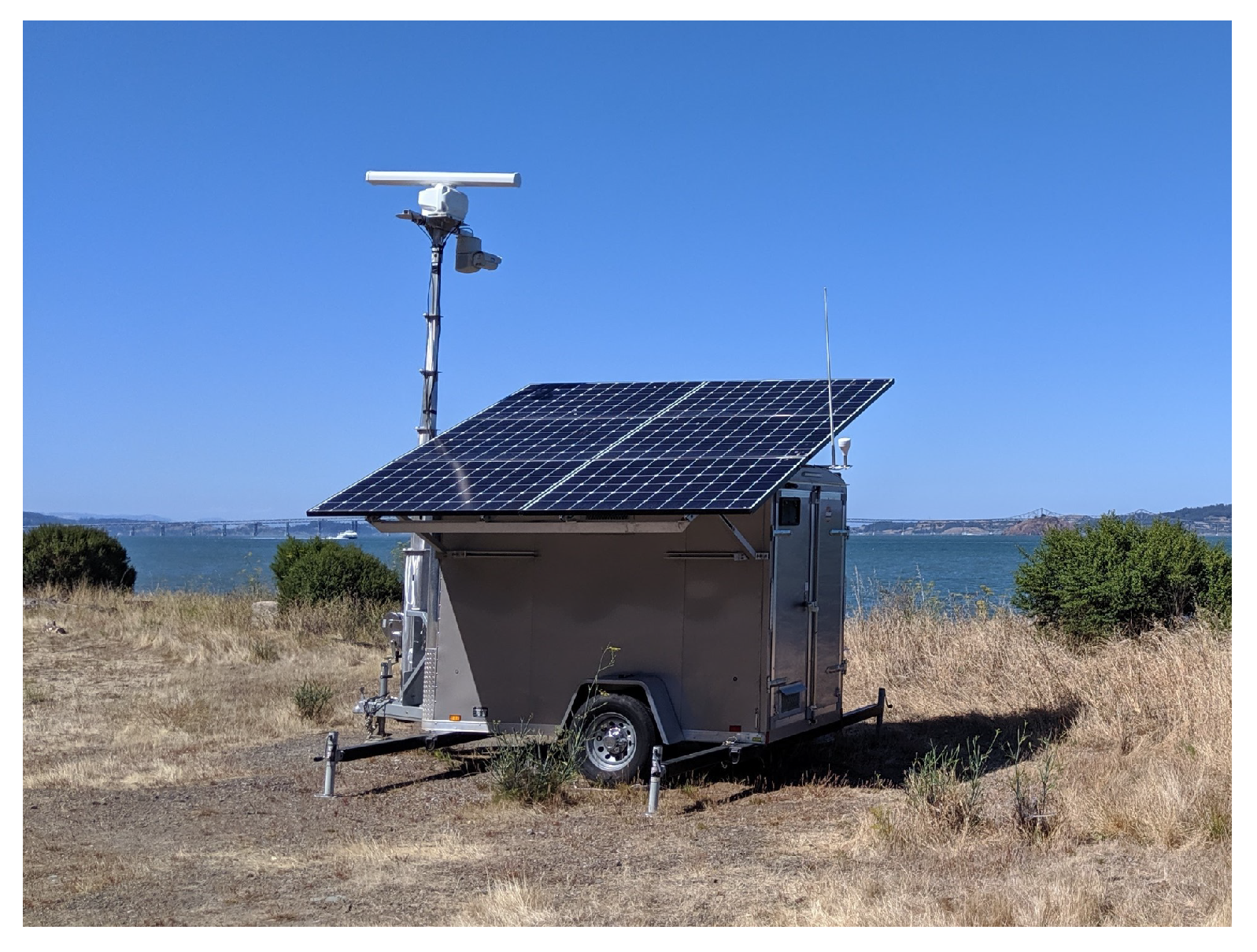
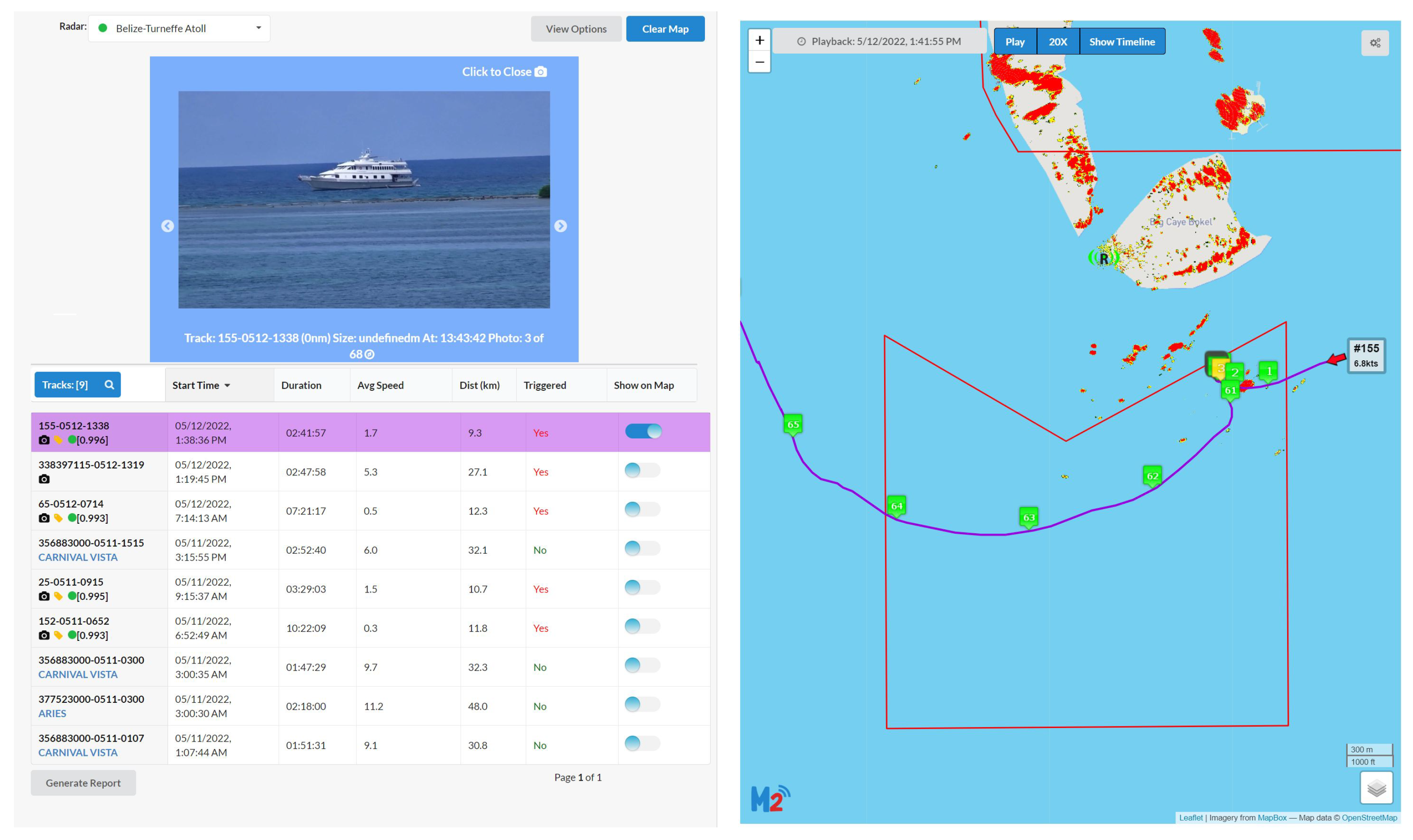
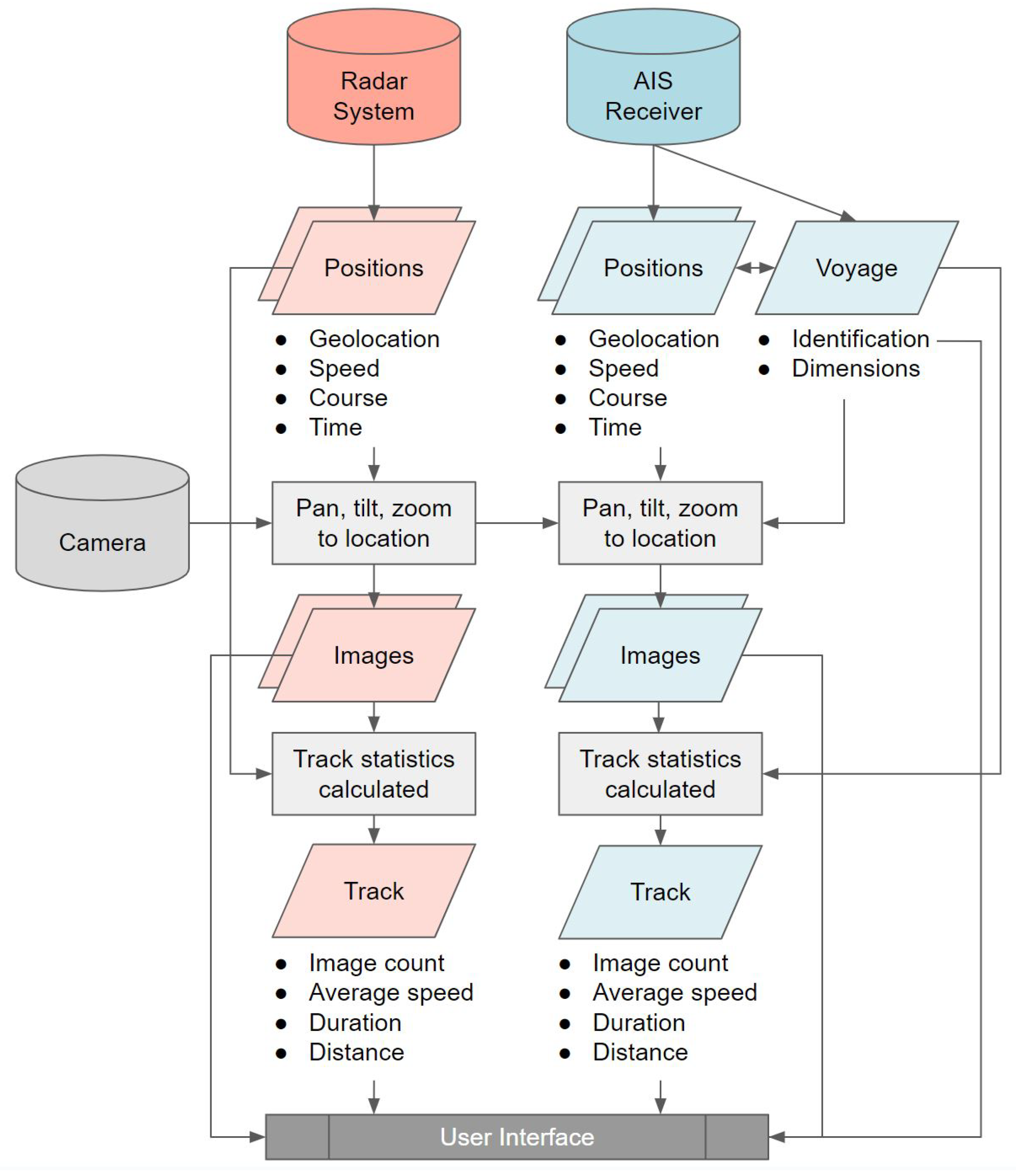

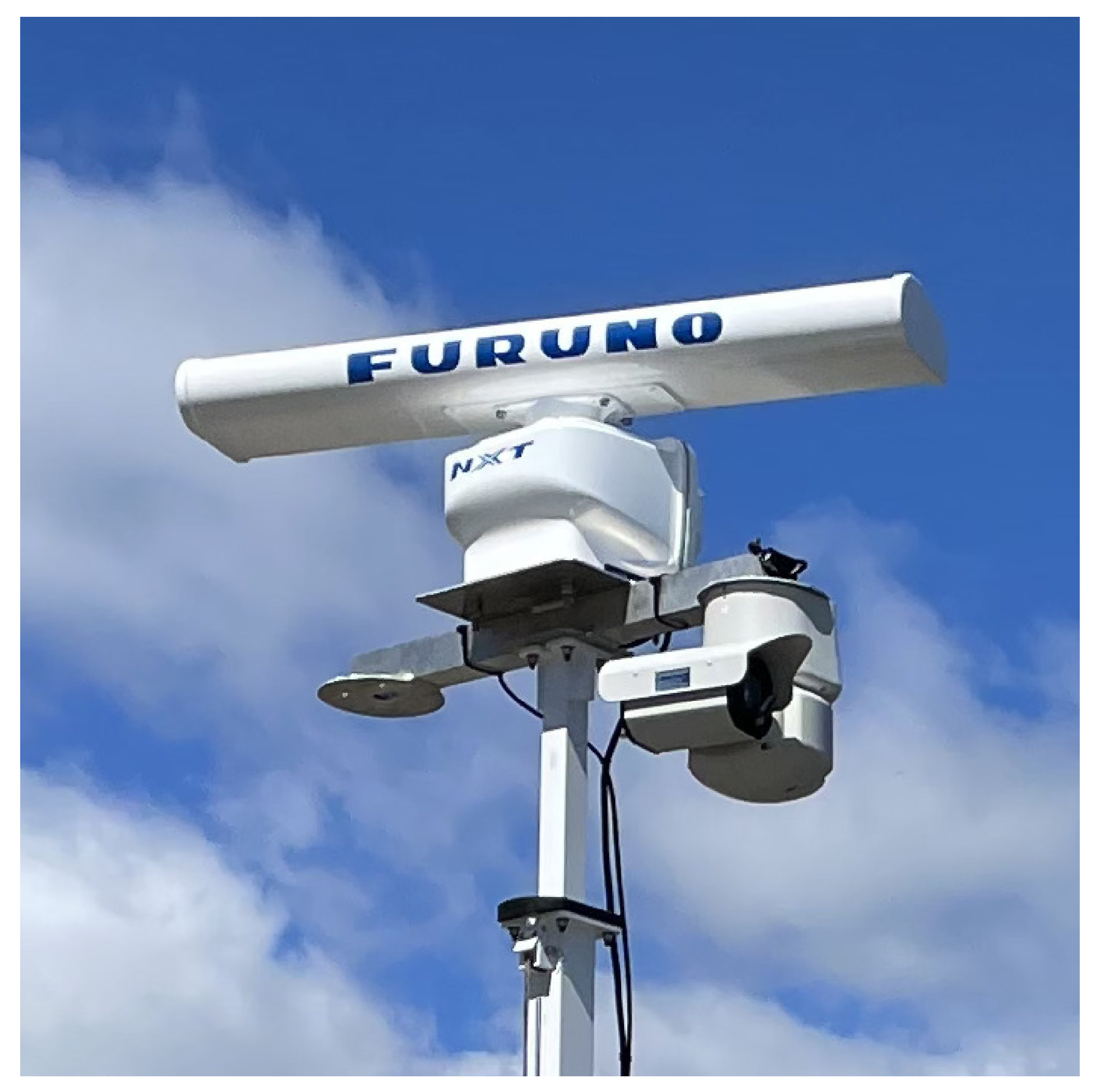


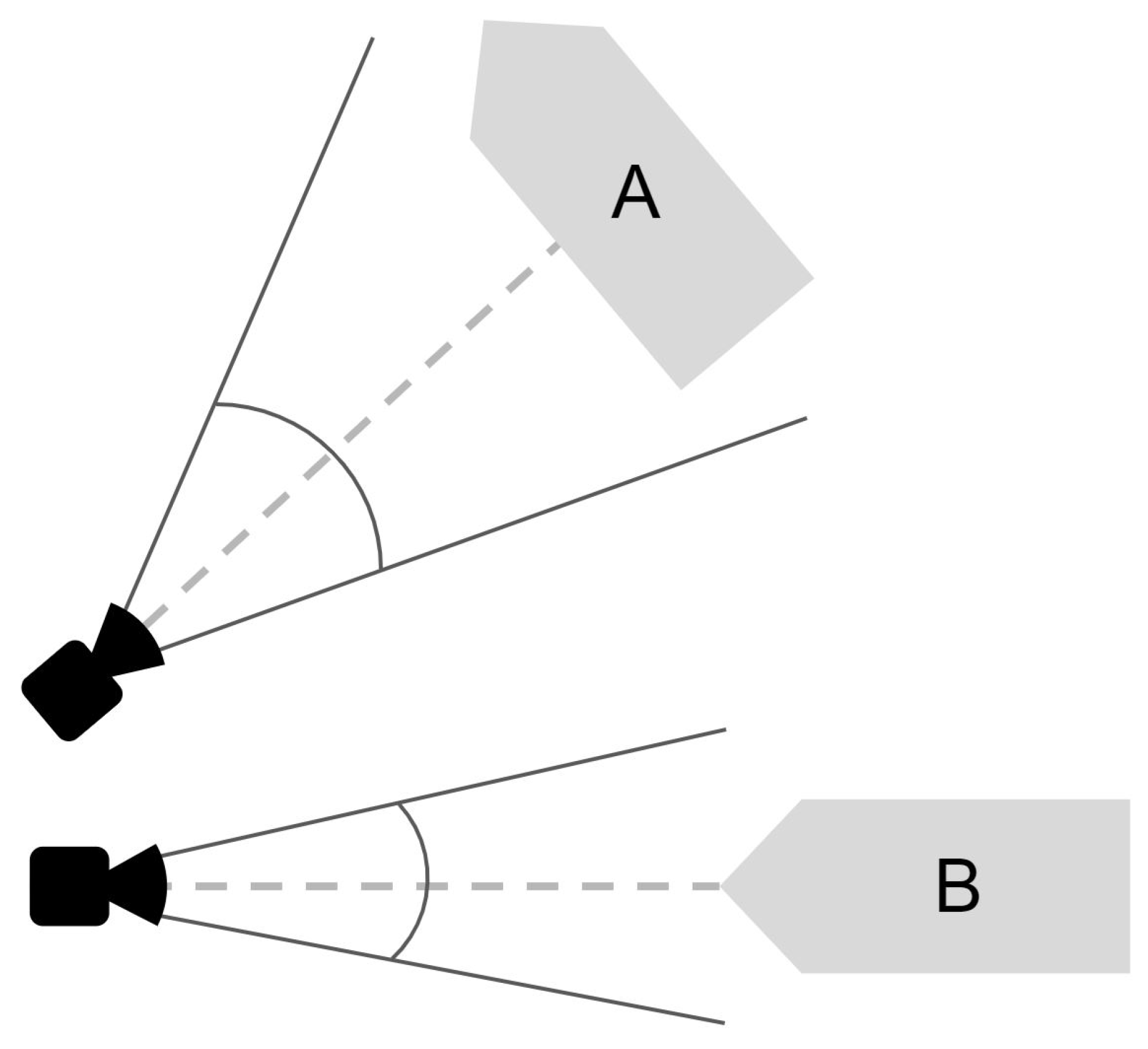
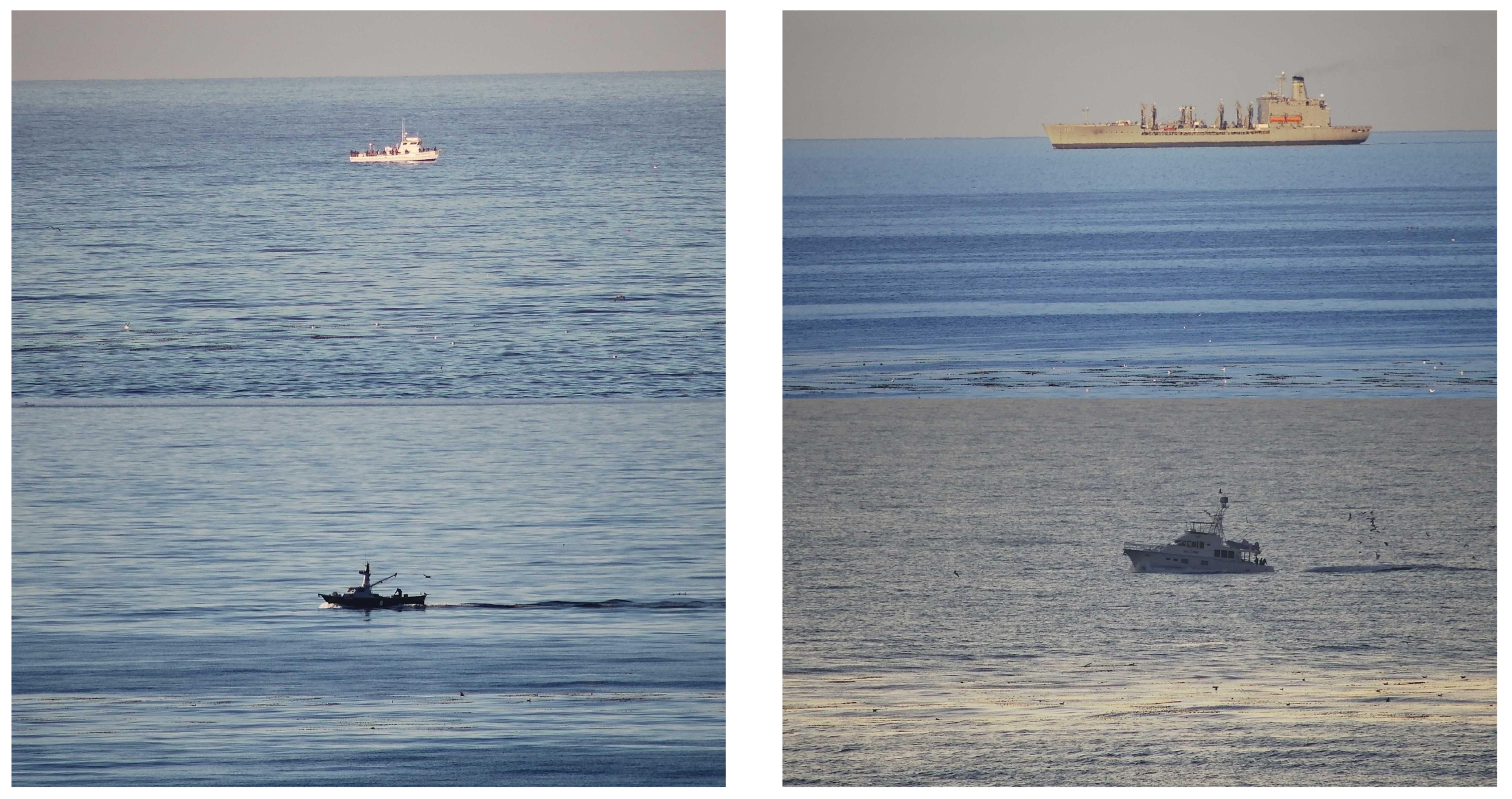
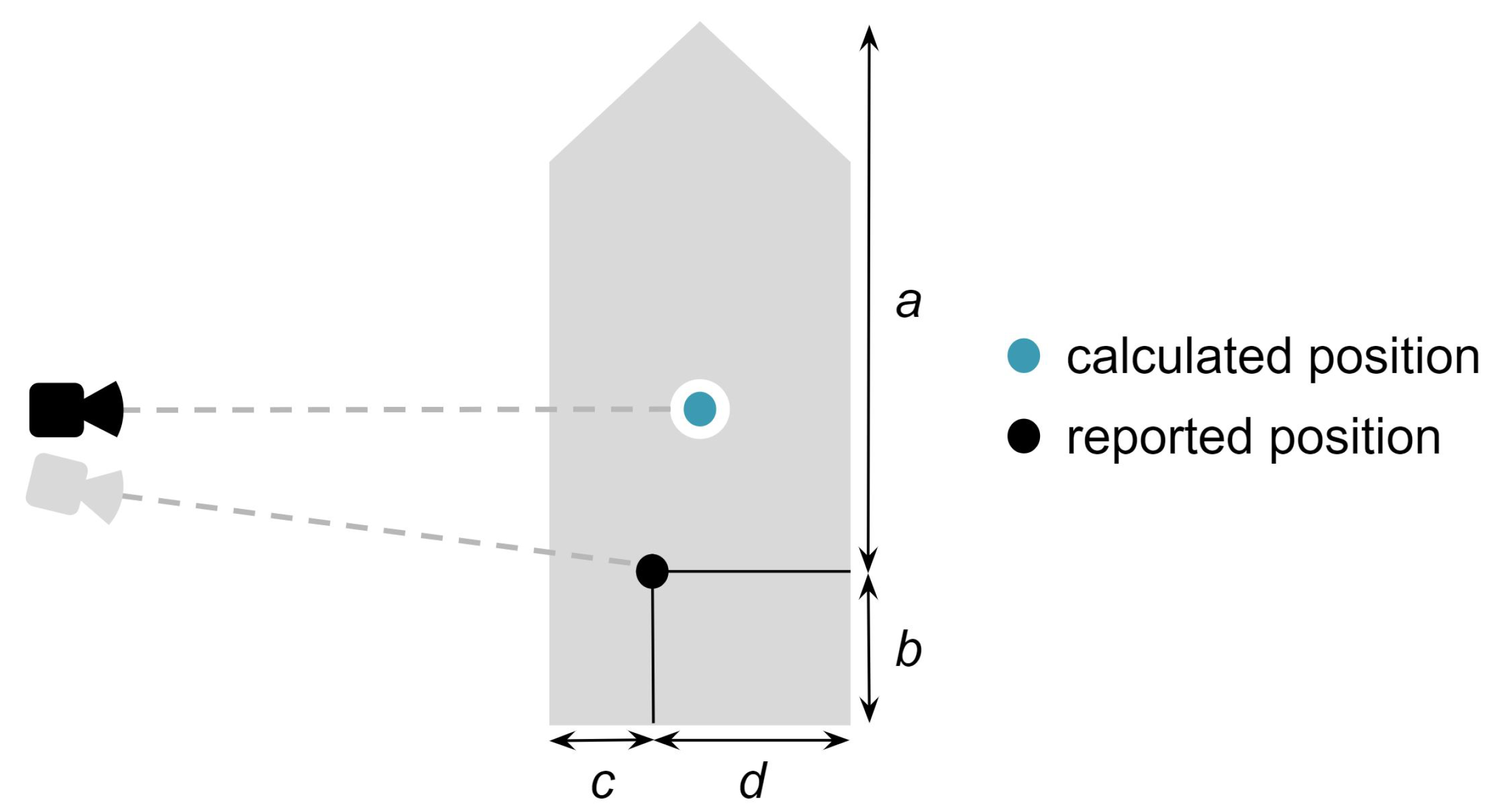
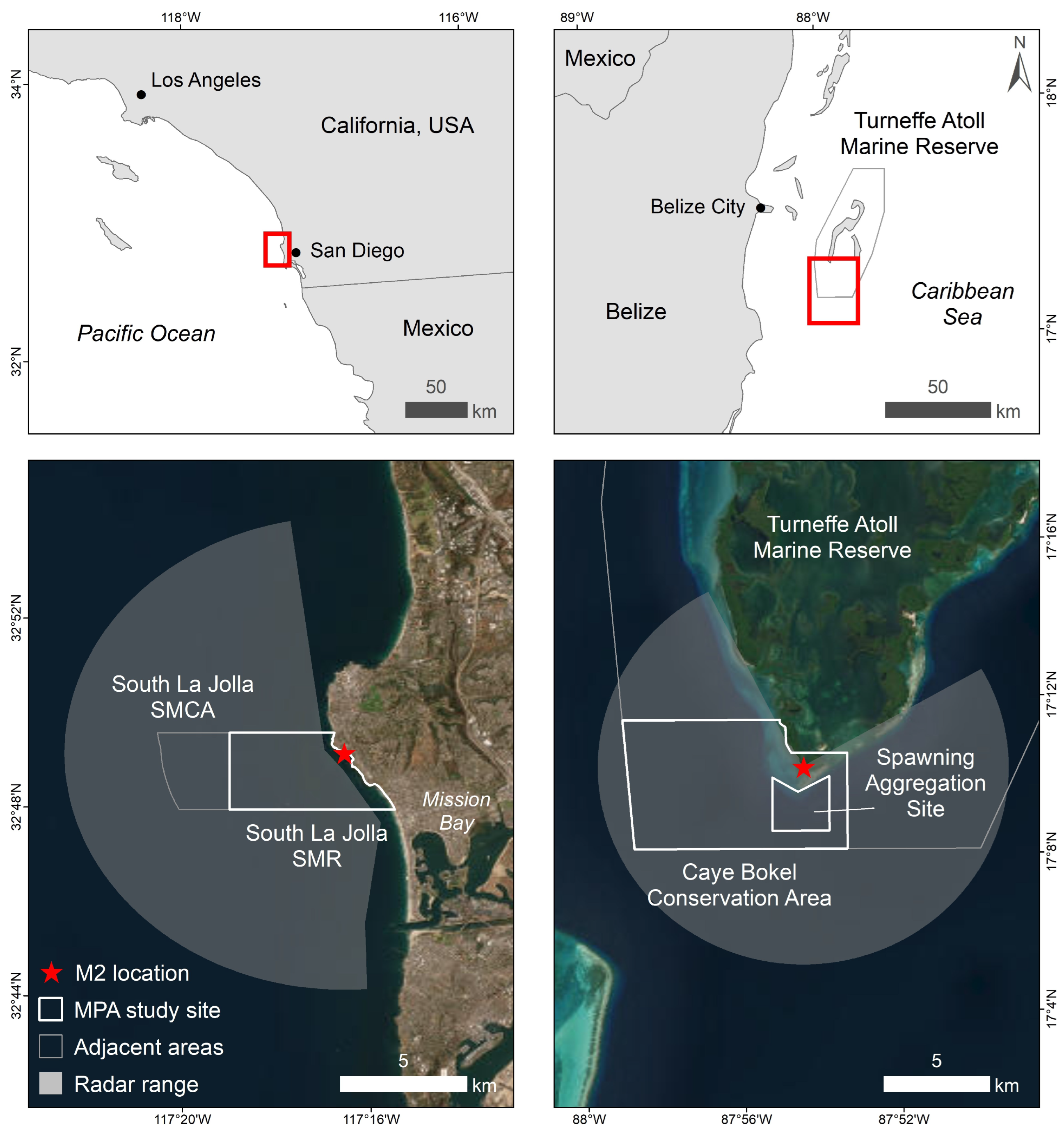

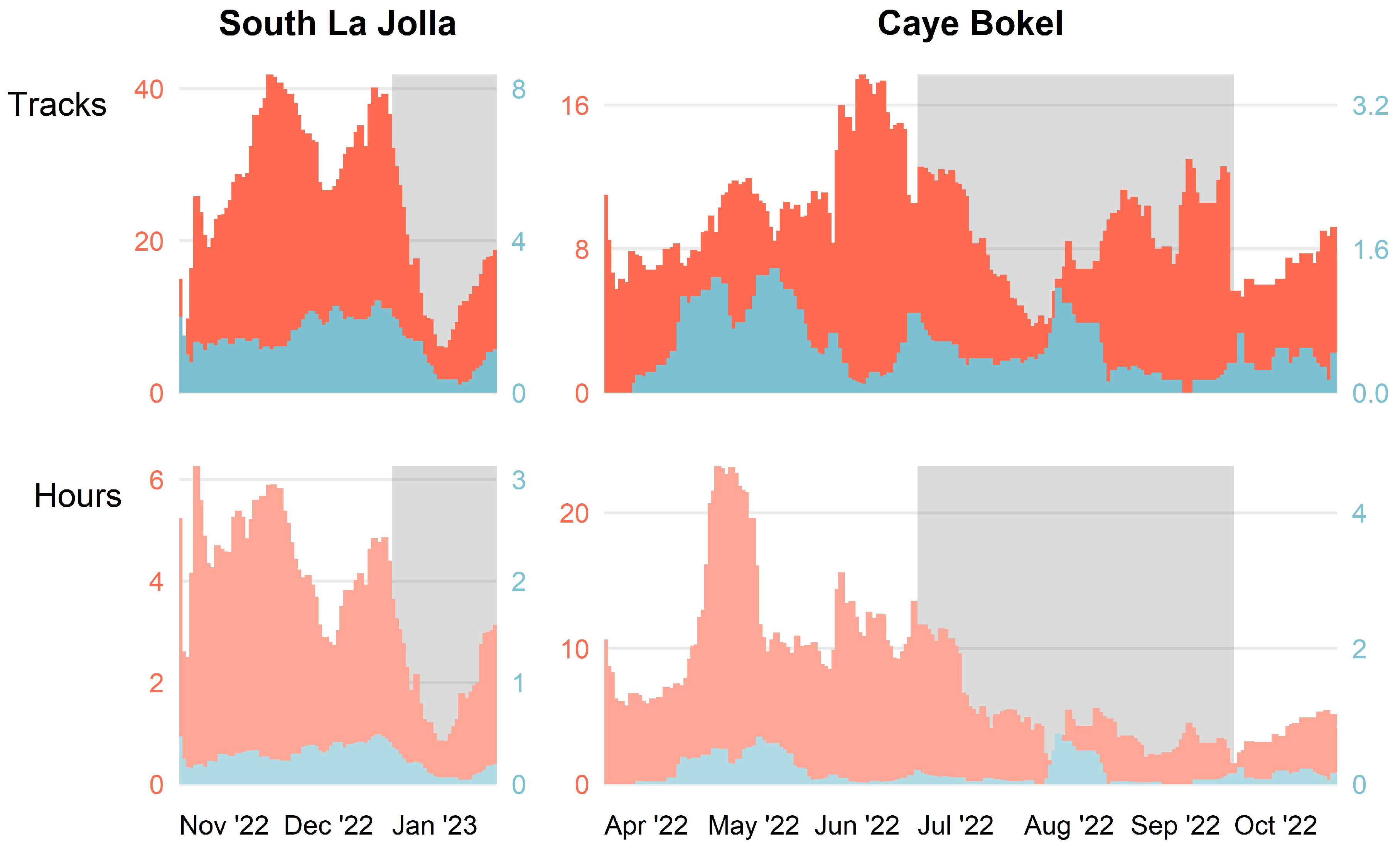

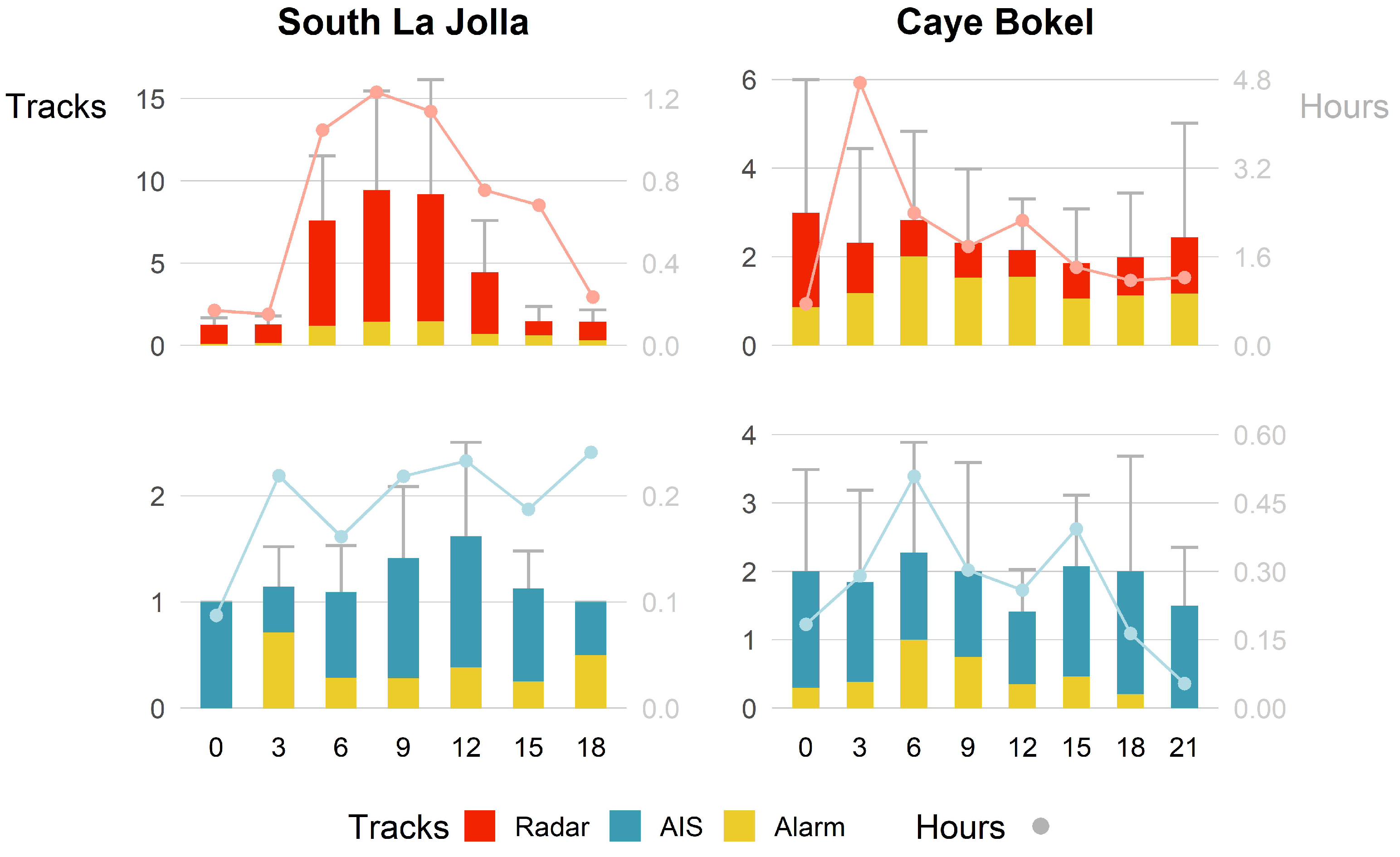

| South La Jolla | Caye Bokel | ||||
|---|---|---|---|---|---|
| Total | Daily | Total | Daily | ||
| Tracks | |||||
| Radar | 2284 () | 1404 () | |||
| AIS | 125 | 81 | |||
| Hours | |||||
| Radar | () | () | |||
| AIS | |||||
| Images | |||||
| Radar | 23,587 | 18,997 | |||
| AIS | 7205 | 1160 | |||
Disclaimer/Publisher’s Note: The statements, opinions and data contained in all publications are solely those of the individual author(s) and contributor(s) and not of MDPI and/or the editor(s). MDPI and/or the editor(s) disclaim responsibility for any injury to people or property resulting from any ideas, methods, instructions or products referred to in the content. |
© 2023 by the authors. Licensee MDPI, Basel, Switzerland. This article is an open access article distributed under the terms and conditions of the Creative Commons Attribution (CC BY) license (https://creativecommons.org/licenses/by/4.0/).
Share and Cite
Cope, S.; Tougher, B.; Zetterlind, V.; Gilfillan, L.; Aldana, A. Building a Practical Multi-Sensor Platform for Monitoring Vessel Activity near Marine Protected Areas: Case Studies from Urban and Remote Locations. Remote Sens. 2023, 15, 3216. https://doi.org/10.3390/rs15133216
Cope S, Tougher B, Zetterlind V, Gilfillan L, Aldana A. Building a Practical Multi-Sensor Platform for Monitoring Vessel Activity near Marine Protected Areas: Case Studies from Urban and Remote Locations. Remote Sensing. 2023; 15(13):3216. https://doi.org/10.3390/rs15133216
Chicago/Turabian StyleCope, Samantha, Brendan Tougher, Virgil Zetterlind, Lisa Gilfillan, and Andres Aldana. 2023. "Building a Practical Multi-Sensor Platform for Monitoring Vessel Activity near Marine Protected Areas: Case Studies from Urban and Remote Locations" Remote Sensing 15, no. 13: 3216. https://doi.org/10.3390/rs15133216
APA StyleCope, S., Tougher, B., Zetterlind, V., Gilfillan, L., & Aldana, A. (2023). Building a Practical Multi-Sensor Platform for Monitoring Vessel Activity near Marine Protected Areas: Case Studies from Urban and Remote Locations. Remote Sensing, 15(13), 3216. https://doi.org/10.3390/rs15133216







